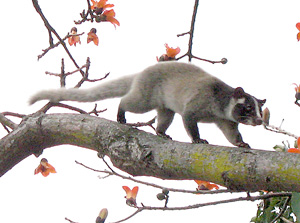Just as the deadly Sudden Acute Respiratory Syndrome (SARS) outbreak of 2003 reaches its 10th anniversary, we find ourselves confronting the recent emergence of the new H7N9 avian influenza virus—an uncomfortable reminder of what a close call the world had with SARS as a potential pandemic.

The palm civet, wrongly targeted as a SARS vector. Photo: denn/Flickr
As the UCS Center for Science and Democracy’s first Science and Democracy Case Study shows, scientists had the expertise back in 2003 to prevent SARS from becoming a pandemic, but putting that knowledge into action required worldwide collaboration among scientists that almost didn’t happen.
The new bird flu is again prompting the need for international collaboration among scientists. Will H7N9 learn how to leap not only from birds to people, as it does now, but also from people to people, like SARS? If it does, will we succeed in containing it in time to prevent it from becoming a pandemic? So far, it seems the international community, including the Chinese, may have learned a lesson or two from SARS about the importance of promoting the freest flow of scientific information during a public health crisis.
No Respect for Borders
Back in the spring of 2003, SARS emerged from the live animal markets in China’s Guangdong Province and quickly became a threat to be reckoned with from Hong Kong and Singapore to Vietnam, Toronto, and more than 20 other countries.
SARS made over 8,000 people sick, killed almost 800, and caused major headaches for the international public health community, as well as for businesses, policymakers, and ordinary citizens around the world. People cancelled travel plans, bought face masks, worried about loved ones, and needlessly killed thousands of poor civet cats (scientists initially thought humans caught SARS from civets but later traced the virus’s evolutionary path to horseshoe bats).
SARS, like other zoonotic viruses (i.e. originating in other animals and travelling to humans), had no respect for either national borders or species boundaries. To make matters worse, China was reluctant to work with outside researchers and delayed crucial evidence gathering until it was almost too late.
Meanwhile, the virus was figuring out ever better ways of ensuring its survival by moving from bats to humans, from humans to humans, and from country to country as a stowaway in the respiratory systems of unsuspecting passengers on international flights. And China was imposing political barriers on the free flow of scientific information that helped the virus rather than humanity. The very same barriers that prevented researchers from learning more about the virus gave the virus itself more time to gain information coded in the genetic material of its hosts—information that helped it learn how to thrive in human communities.
The Need for Transparency
When Dr. Jiang Yanyong, a semi-retired Beijing surgeon, began observing far more patients in local hospitals sick with SARS than Chinese officials were reporting, his conscience bothered him. Despite the risk of personal repercussions, he took the courageous step of making a statement to the international press because, he said, “A failure to disclose accurate statistics about the illness will only lead to more deaths … As a doctor who cares about people’s lives and health, I have a responsibility to aid international and local efforts to prevent the spread of SARS.”
By recognizing the need for transparency, Dr. Yanyong prompted the international pressure that led to full Chinese cooperation. Scientists from the World Health Organization (WHO), the U.S. Centers for Disease Control and Prevention (CDC), and other cooperating labs were finally able to fully and freely share data with their Chinese counterparts and expand their investigations into the hardest hit areas of China where they could collect samples, observe the environments in which the virus had evolved, and talk openly with researchers in China who had studied the outbreak’s unfolding from the front lines.
Only then were scientists able to understand SARS well enough to contain it before it became a pandemic rather than the set of deadly but isolated epidemics it turned out to be.
A Freedom Loving Species
As H7N9 continues its own evolutionary journey from birds to people, we would do well to learn not only from our past experience with SARS but from the viruses themselves. Viruses love freedom. They are democratic. They thrive, evolve, and survive by sharing information.
So must we.
